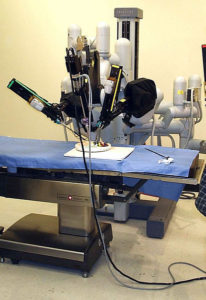Either part or all of the colon is removed surgically by a surgical machine operated by a surgeon.

What is it?
A robotic colectomy is a minimally invasive surgery that utilizes a robotic surgery system to remove all or part of the colon in order to treat conditions of the colon such as cancer, bowel obstructions, or excessive bleeding. Different variations of colectomies include total colectomies, partial colectomies, hemicolectomies (removes only the right or left part of the colon), and proctocolectomies (removes the colon and rectum). A robotic colectomy differs from a traditional colectomy in that it uses an advanced robotic system controlled by the surgeon that results in less tissue trauma, smaller incisions, and improved visualization and ability. The robotic system has arms with surgical instruments that are controlled by the surgeon in order to create more precise, controlled movements. Typically, patients experience less pain, faster recovery, and shorter hospital stays with robotic versus traditional colectomies. Robotic colectomies are the latest advancement in colectomy procedures.
How to Prepare
If a patient is having a robotic colectomy, the patient should stop taking blood thinners, aspirin, and nonsteroidal anti-inflammatory medications for one week prior to the surgery. These medications can increase the risk of bleeding during the surgery, which can be a major complication. Patients should check with their physicians before ceasing medications because other medical problems may determine whether or not they should be stopped. A laxative solution will likely be ordered by the doctor in order to clear the bowels at home prior to the surgery. The patient should not eat or drink starting from the midnight prior to the surgery in order to reduce the risk of aspiration, a rare but serious risk that occurs when the stomach’s contents enter the lungs during general anesthesia. Additionally, it’s possible that the doctor will prescribe antibiotics to take prior to the surgery in order to prevent infection during it.
What happens during the procedure?
During a robotic colectomy, the patient receives general anesthesia, which are anesthetic drugs that put the patient to sleep for the duration of the procedure. Once anesthetized, the surgeon starts the procedure by making several small incisions in the abdomen in order to insert surgical instruments and a small, surgical camera inside the body. The surgeon can view the inside of the body and the surgery via the camera. Carbon dioxide is used to inflate the abdomen so that the surgeon has more space to perform the procedure. The surgeon works entirely behind the robotic console, where he or she controls the movements of the robotic arms, instruments, and camera. The console also contains a screen that projects the high definition, real-time video so that the surgeon can see the procedure as it occurs. As with a traditional colectomy, the surgeon will excise the diseased or damaged portion of the colon and suture the remaining portions together. If the patient’s medical condition requires a total colectomy, the small intestine is connected to the anus. In other instances, the intestines are attached to an opening in the abdomen so that waste is removed via the opening. The type of operation the patient must undergo depends on their medical condition.
Risks and Complications
Risks associated with a colectomy include infection, bleeding, damage to internal organs near the surgery site, blood clots, and damage to the sutures that reconnect the colon. Risks associated with general anesthesia include aspiration.
Disclaimer:
All GlobeHealer Site content, including graphics, images, logos, and text, among other materials on the site are for educational purposes only. This content is not intended to be a substitute for professional medical advice, and you should always contact your physician or qualified health provider for information regarding your health. Information on this site regarding the overview, diagnosis, and treatment of any kind should be looked at, in addition to the advice and information of your health care professional. Do not disregard medical advice or delay seeking treatment or medical advice due to information found on the GlobeHealer site.
If there is even the possibility that you may have a medical emergency, seek treatment, call your doctor, or call your local emergency telephone number immediately. GlobeHealer does not endorse being the first line of communication in case of emergency and does not endorse any specific test, physician, facility, product, procedure, opinion, or other information that is or may be mentioned on this site or affiliated entities. Reliance of any and all information provided by GlobeHealer, its employees, affiliations, others appearing on the Site under the invitation of GlobeHealer, or visitors of the site is solely at your own risk and is not the responsibility of GlobeHealer.
Image Source:
https://commons.wikimedia.org/wiki/File:Laproscopic_Surgery_Robot.jpg
